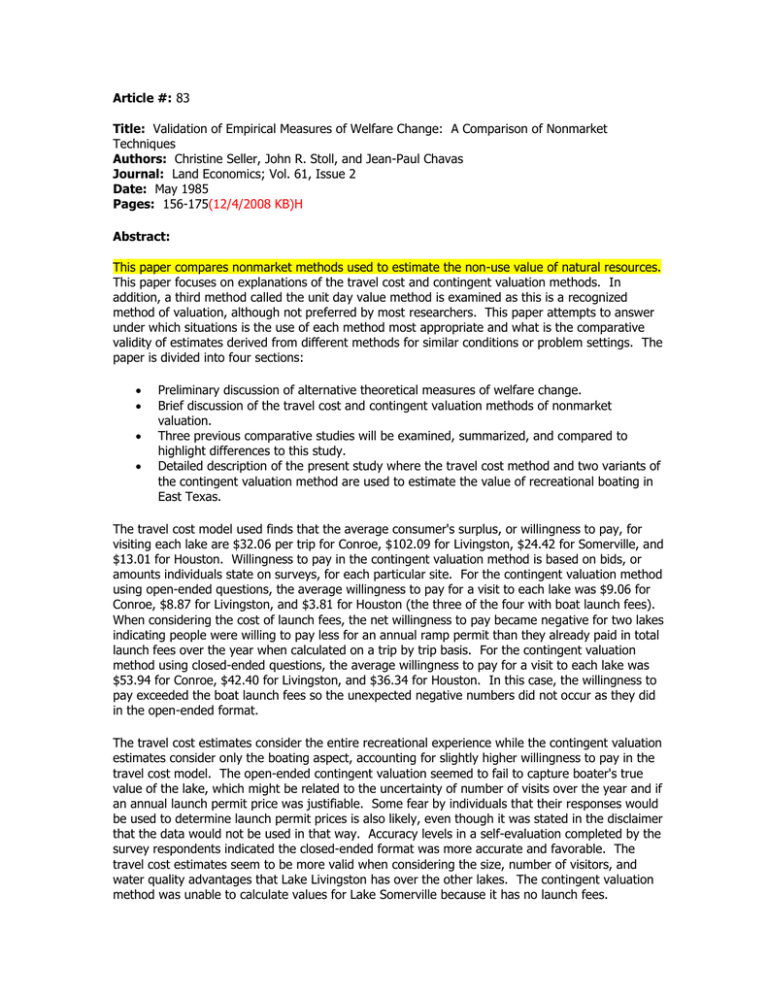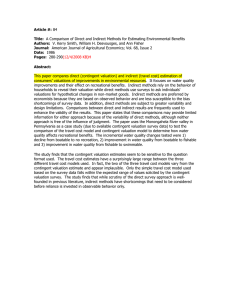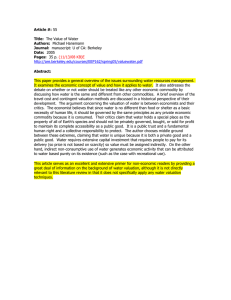Document 12013437
advertisement

Article #: 83 Title: Validation of Empirical Measures of Welfare Change: A Comparison of Nonmarket Techniques Authors: Christine Seller, John R. Stoll, and Jean-Paul Chavas Journal: Land Economics; Vol. 61, Issue 2 Date: May 1985 Pages: 156-175(12/4/2008 KB)H Abstract: This paper compares nonmarket methods used to estimate the non-use value of natural resources. This paper focuses on explanations of the travel cost and contingent valuation methods. In addition, a third method called the unit day value method is examined as this is a recognized method of valuation, although not preferred by most researchers. This paper attempts to answer under which situations is the use of each method most appropriate and what is the comparative validity of estimates derived from different methods for similar conditions or problem settings. The paper is divided into four sections: Preliminary discussion of alternative theoretical measures of welfare change. Brief discussion of the travel cost and contingent valuation methods of nonmarket valuation. Three previous comparative studies will be examined, summarized, and compared to highlight differences to this study. Detailed description of the present study where the travel cost method and two variants of the contingent valuation method are used to estimate the value of recreational boating in East Texas. The travel cost model used finds that the average consumer's surplus, or willingness to pay, for visiting each lake are $32.06 per trip for Conroe, $102.09 for Livingston, $24.42 for Somerville, and $13.01 for Houston. Willingness to pay in the contingent valuation method is based on bids, or amounts individuals state on surveys, for each particular site. For the contingent valuation method using open-ended questions, the average willingness to pay for a visit to each lake was $9.06 for Conroe, $8.87 for Livingston, and $3.81 for Houston (the three of the four with boat launch fees). When considering the cost of launch fees, the net willingness to pay became negative for two lakes indicating people were willing to pay less for an annual ramp permit than they already paid in total launch fees over the year when calculated on a trip by trip basis. For the contingent valuation method using closed-ended questions, the average willingness to pay for a visit to each lake was $53.94 for Conroe, $42.40 for Livingston, and $36.34 for Houston. In this case, the willingness to pay exceeded the boat launch fees so the unexpected negative numbers did not occur as they did in the open-ended format. The travel cost estimates consider the entire recreational experience while the contingent valuation estimates consider only the boating aspect, accounting for slightly higher willingness to pay in the travel cost model. The open-ended contingent valuation seemed to fail to capture boater's true value of the lake, which might be related to the uncertainty of number of visits over the year and if an annual launch permit price was justifiable. Some fear by individuals that their responses would be used to determine launch permit prices is also likely, even though it was stated in the disclaimer that the data would not be used in that way. Accuracy levels in a self-evaluation completed by the survey respondents indicated the closed-ended format was more accurate and favorable. The travel cost estimates seem to be more valid when considering the size, number of visitors, and water quality advantages that Lake Livingston has over the other lakes. The contingent valuation method was unable to calculate values for Lake Somerville because it has no launch fees.








